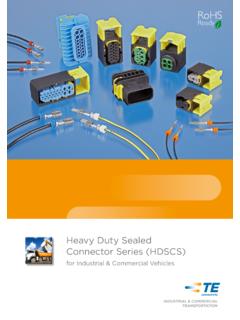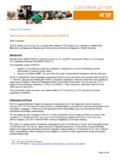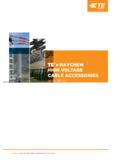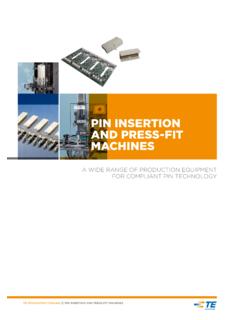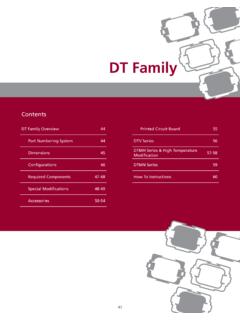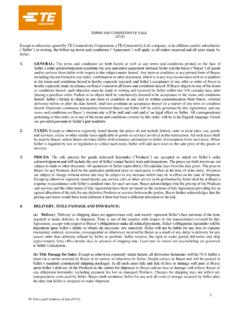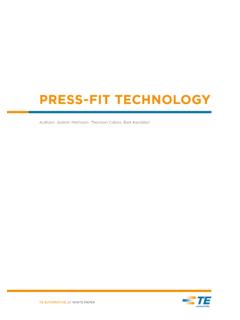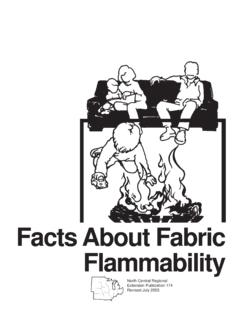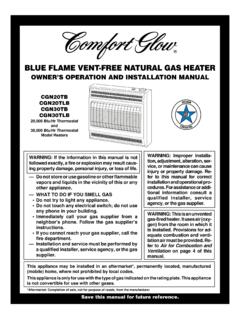Transcription of Glow Wire Testing - TE Connectivity: Connectors & …
1 White Paper 23 May 2013 Rev A 503-32020 glow wire Testing FOR THE APPLIANCE INDUSTRY 2013 Tyco Electronics Corporation, a TE Connectivity Ltd. company All Rights Reserved | Indicates Change 1 of 8 *Trademark. TE Connectivity, TE connectivity (logo), and TE (logo) are trademarks. Other logos, product and/or Company names may be trademarks of their respective owners. Background afety is paramount in the home appliance industry. Due to the possibility of human mis-application, over-current, or short circuit failures within an appliance wiring system, fire protection requirements were created to evaluate and rate the flammability of material used within an appliance.
2 glow wire Testing is one such requirement used within the appliance industry today. This paper explores glow wire Testing , describes the rationale behind the glow wire test procedures and briefly compares the practice to other common flammability test methods. The paper also sheds light on the specifications governing the glow wire Testing practice. Finally, it shows TE s commitment toward providing a range of products to help appliance customers meet the glow wire flammability requirements. What is glow wire Testing ? Historically a number of methods have been developed to evaluate material flammability and fire resistance.
3 These include both direct flame and indirect flame Testing methods. An example of the direct flame method is defined in the UL 94 specification. This long accepted test method involves applying a flame directly to a vertically or horizontally mounted specimen under controlled conditions. On the other hand, the indirect flame method features a non-flaming heat source applied to a sample. glow wire Testing is an example of the indirect flame method. Test results from applying these methods provide a way to compare the materials tendency to resist ignition, self-extinguish flames (should ignition occur), and to not propagate fire via dripping.
4 To better understand the differences between the direct method and the indirect method, refer to Figure 2. Photographs courtesy of: TE Connectivity S Page 2 of 8 The International Electrical Commission (IEC) established the glow - wire Testing method in 2001 because existing test methods did not cover all ignition sources. Specifically, the glow wire test is used to simulate heating effects that may arise in malfunctioning electrical equipment caused by an overloaded connection or component that is overheating.
5 glow wire Test Methodology glow wire requirements for home appliances are specified in IEC 60335-1. However, the actual glow wire test methodology is covered in the IEC 60695-2 series of specifications. glow wire Testing is performed by heating an element to a pre-determined temperature. The heated element is referred to as the glow wire . See figure 3 for an example of the heated element used for glow wire Testing . The sample to be tested is fixture in place and tissue paper is positioned directly below the sample. After reaching the pre-determined temperature, the element is then pressed into a sample material under a set force of 1N for 30 seconds.
6 If ignition occurs, recordings are made to note the duration, flame height, and if drips of the material ignite the tissue paper. glow wire Testing can be performed on both end products and raw material test plates. The terminology used to define compliance in each case is slightly different. 1. GWT stands for glow wire Test (IEC 60695-2-11). GWT is used when glow wire Testing is performed on an end product. The results of this test will be either PASS or FAIL at a given temperature. Passing the test requires that the sample does not ignite or self-extinguishes within 30 seconds after removal of the heated element.
7 Also, the sample may not ignite the tissue paper if drips occur. Photographs provided by TE Connectivity Page 3 of 8 2. GWFI stands for glow wire Flammability Index (IEC 60695-2-12). This is a property associated with raw material used in the end product. This property is determined by conducting the glow wire test on a test plate of a raw material of a given thickness. The glow wire Flammability Index (GWFI) is the highest temperature at which the material does not ignite or self-extinguishes within 30 seconds after removal of the heated element. 3. GWIT stands for glow wire Ignition Temperature (IEC 60695-2-13).
8 This is a property associated with raw material used in the end product. This property is determined by conducting the glow wire test on a test plate of a raw material of a given thickness. The glow wire Ignition Temperature (GWIT) is the lowest temperature at which the material ignites and burns for longer than 5 seconds while the heated element is in contact with the test plate. Knowledge of the three terms is essential to understand how glow wire Testing is applied under the overall safety standard IEC 60335-1. glow wire Testing and IEC 60335-1: Safety of Household and Similar Electrical Appliances IEC 60335-1 is a general specification that governs the safety of household appliances.
9 Within the specification, glow wire Testing is used to evaluate flammability of non-metallic materials supporting current carrying connections used within the appliance. The glow wire test severity prescribed in IEC 60335-1 is determined by whether the appliance is attended or unattended during use, and by the amount of current that is carried by the connection. Attended appliances are basically any appliance that is operated by an attending consumer such as vacuum cleaners, irons, and coffee FIGURE 3 - Typical glow wire setup showing heated element glowing red/yellow in color.
10 (Temperature set to 750 C) Photo provided by: TE Connectivity Page 4 of 8 pots. Unattended appliances are those that are set in place and operated on their own. Such examples include refrigerators, cooking units, dishwashers, washing machines, and dryers. Connectors used in an application that is categorized as unattended with current greater than are subject to the most severe evaluation. To comply with this specification, three levels of flammability evaluation may be required: In order to pass the first level of evaluation, the material must have a minimum GWFI 850 C OR the end product must pass the glow wire test at 850 C.

